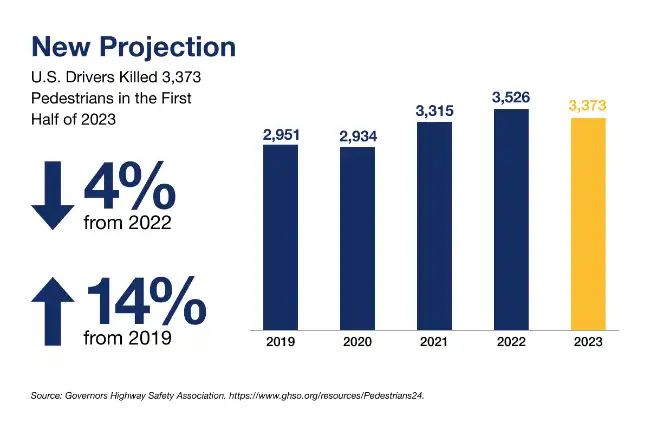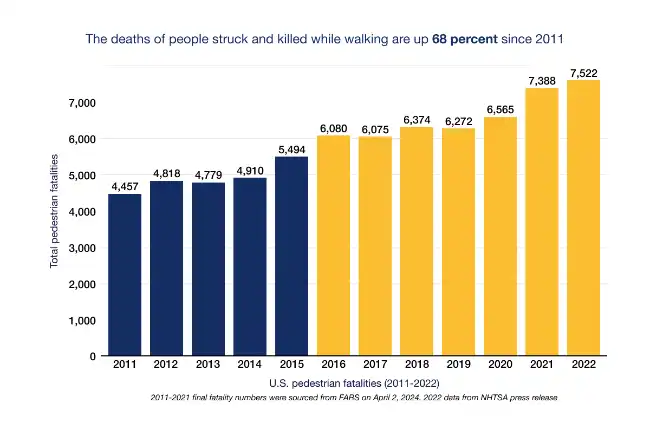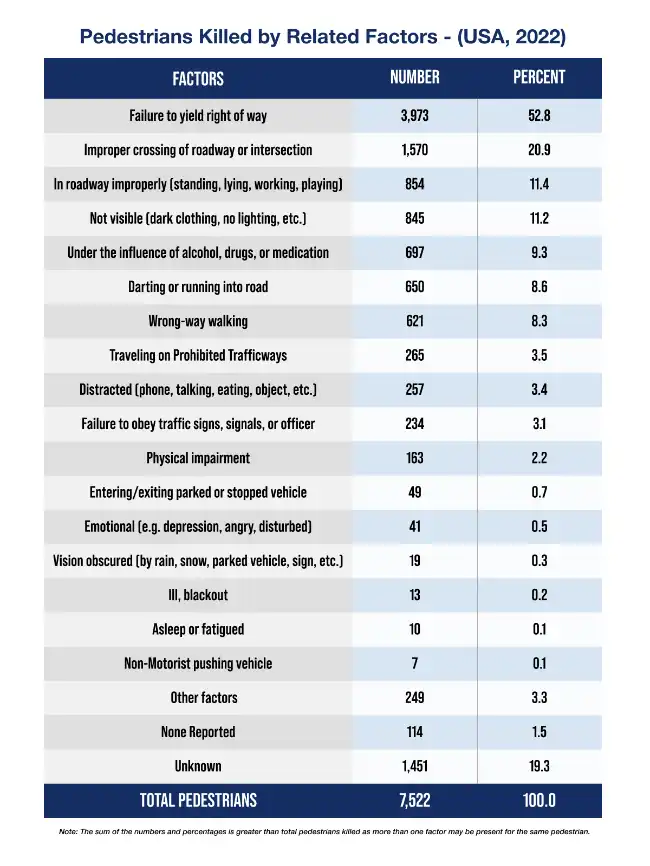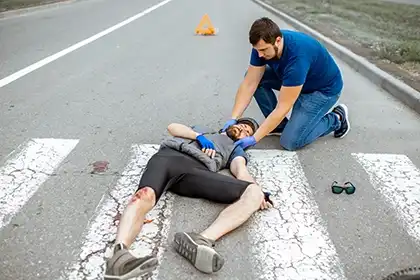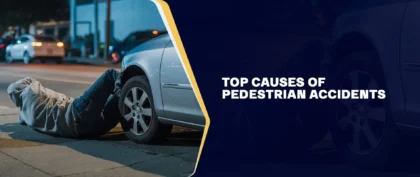Table of Contents
Have you ever come dangerously close to a vehicle while walking or running down the street? Such encounters can leave you questioning how frequent pedestrian accidents really are. Sadly, these incidents occur with alarming regularity in the United States.
Determining the exact number of pedestrian accidents within a given timeframe is challenging because most available data only accounts for reported fatalities and injuries. Many accidents go undocumented, either because they are not reported to authorities or do not require medical attention.
However, while we may not have a complete count of all pedestrian incidents, the data on documented deaths and injuries still provides a valuable estimate of how often these accidents occur. By analyzing these figures, we can identify trends, assess risk factors, and understand the broader impact of pedestrian safety issues on U.S. roads.
The National Highway Traffic Safety Administration (NHTSA) reported that traffic accidents in the U.S. claimed the lives of about 42,514 people in 2022; 7,522 were pedestrians. The data also showed that, on average, about 21 pedestrians die every day. This means that every 70 minutes, a pedestrian dies in a traffic accident. Additionally, more than 67,300 pedestrians were injured that year, equating to approximately one injury every eight minutes.
Preliminary data from the Governors Highway Safety Association (GHSA) reported that pedestrian deaths have risen seven times the population growth rate between the first half of 2019 and 2023.
How Many Pedestrian Accidents Happen In The U.S. Annually?
While pedestrian accidents are a critical public concern in the United States, there is no exact data on how many occur each year. However, reputable agencies and organizations release statistics on pedestrian fatalities and injuries, which provide insight into the scale of the problem. According to preliminary data from the Governors Highway Safety Association, 3,373 pedestrians died in traffic-related accidents in the first half of 2023. Pedestrian deaths have risen in recent years, but there’s been a slight 4% decrease (153 fewer deaths) compared to the same time in 2022. However, this is still a 14% increase from 2019.
Streetlight, a mobility company, found that pedestrian deaths rose by 20% between 2019 and 2022. Interestingly, this happened despite a 36% drop in walking trips during the same time. The report highlights the paradox that fewer people walking may be contributing to more fatalities.
The ‘safety in numbers’ effect means that when fewer people walk, drivers aren’t as used to looking out for pedestrians. This can lead to riskier driving, like ignoring crosswalks or not yielding. Our car-focused culture, which often prioritizes vehicles over pedestrians, makes this worse. As a result, streets might be designed with less thought for pedestrian safety, increasing the danger for those who are walking.
Trends In Pedestrian Fatalities
According to recent data, pedestrian fatalities have been on the rise from 2010 to 2022, with only small decreases in 2013, 2017, and 2019. Over this period, pedestrian deaths surged by 77%, while other traffic fatalities increased by just 22%. This trend reflects a growing danger for pedestrians, as their share of total traffic deaths has consistently risen, except in 2020.
Records on these fatalities help paint a clearer picture of the magnitude of the issue, highlighting the growing risks pedestrians face on the roads. However, it’s important to remember that different agencies and organizations may report varying numbers, as each tracks these incidents differently using distinct methods and criteria.
In 2020, 6,712 pedestrians were killed in traffic incidents. This number increased to 7,443 in 2021 and then rose again to 7,737 in 2022. However, in 2023, the estimated deaths are expected to drop slightly to around 7,318. This is a 5.4% decrease from 2022 but still 14.1% higher than in 2019. Overall, the long-term trend of pedestrian fatalities is concerning.
According to another source (NHTSA), in 2020, there were 6,565 pedestrian deaths, which went up to 7,388 in 2021, equal to one death every 71 minutes. In 2022, the number rose to about 7,522. While these numbers are a bit lower than the previous source because they track differently, the overall trend is still upward.
How Many Pedestrians Are Injured Each Year In The U.S.?
Much like fatality reports, insight into pedestrian injuries gives us a good grasp of the full scale of the number of pedestrian accidents. These injuries can be life-threatening, with severity depending on factors like vehicle speed, collision type, pedestrian age and condition, and the environment. Common injuries from such accidents include head and brain trauma, broken bones, spinal cord damage, amputations, and more.
Pedestrian fatalities often grab headlines, but there’s also a high number of non-fatal injuries each year. In 2022, the Centers for Disease Control and Prevention (CDC) estimated that 140,000 pedestrians went to the emergency department due to non-fatal crash injuries. Meanwhile, data gathered between 2021 and 2023 shows:
- The most common emergency department visits were from individuals aged 15-24 and 25-34.
- Male patients accounted for nearly twice (1.93) as many visits as female patients.
- Autumn (September to November) saw 1.21 times more visits than summer (June to August).
The agency emphasized that previous urban planning, which prioritized vehicles, has resulted in unsafe walking areas and inadequate pedestrian infrastructure. Pedestrians often face risks from speeding drivers or those driving under the influence, leading to more accidents. Poor visibility also adds to the danger.
In 2022, the NHTSA reported 67,336 pedestrian injuries from traffic accidents, marking an 11% increase from 2021. On average, this means a pedestrian was injured every eight minutes.
Factors Contributing To Fatal Pedestrian Accidents
Pedestrians are especially at risk in motor vehicle accidents. Unlike vehicle passengers, they are more prone to severe injuries or fatalities. Often, these tragic events are caused by human error. When drivers speed or ignore traffic laws, they endanger everyone on the road, especially those on foot.
An evaluation of the data from the Fatality Analysis Reporting System (FARS) echoes this concern. One of the top causes of fatal car accidents is drivers failing to yield the right of way. This kind of negligence can happen in several ways, like when drivers are:
- Turning at intersections without yielding to pedestrians or other vehicles.
- Approaching or crossing crosswalks without stopping for pedestrians.
- Speeding through areas where pedestrians are present.
In these situations, the pedestrian is vulnerable, and the failure of the driver to stop or slow down can result in catastrophic injuries or fatalities. Other contributing factors include:
Roadway Characteristics
Pedestrian accidents occur more frequently on specific types of roadways, highlighting the critical role of road design and traffic patterns in pedestrian safety. According to the NHTSA’s summary on pedestrian safety, non-intersection locations accounted for 3% of pedestrian fatalities. A study using FARS data, roadway information, and aerial images found common traits of high-risk roads where pedestrian accidents happen most often. These dangerous roads typically have:
- Five or more lanes.
- Speed limits of 30 mph or higher.
- Over 25,000 vehicles daily.
The Insurance Institute for Highway Safety (IIHS) also highlighted the following statistics from 2022:
- Pedestrian deaths were far more common in urban areas than rural ones, with 85% of fatalities occurring in the former.
- About 33% of pedestrian deaths among older adults occurred in intersection accidents.
- Major roads posed a greater risk than freeways or interstates, accounting for 60% of fatal pedestrian crashes.
- In cities, 51% of pedestrian fatalities occurred on roads with speed limits of 40 mph or less.
- In rural areas, pedestrian deaths were more likely to happen on higher-speed roads, with 63% occurring on roads where the speed limit was 55 mph or higher.
Light Conditions
From 2010 to 2019, pedestrian fatalities increased significantly.
- Nighttime deaths rose by 58%, showing a growing risk in low-light conditions.
- Daytime deaths increased by 16%.
This trend highlights how reduced visibility at night makes walking more dangerous. By 2022, the risk was even more pronounced:
- Around 78% of all pedestrian fatalities happened at night, emphasizing the danger of poor lighting.
- Only 4% occurred at dusk or dawn, meaning twilight hours were less of a factor compared to full darkness.
Time
According to the 2022 NHTSA report, a significant portion of pedestrian fatalities occurred during specific nighttime hours. About 26% of these deaths happened between 9 p.m. and midnight, while another 24% took place between 6 p.m. and 9 p.m. This data means that over half of all pedestrian deaths took place within just a six-hour window after sunset. Coincidentally, most drunk driving accidents also happen during the nighttime.
Hit-And-Run Incidents
Hit-and-run accidents occur when a driver leaves the scene without helping the victim or sharing information. In 2022, hit-and-run drivers were responsible for 25% of pedestrian fatalities, according to the NHTSA. In that year alone, these incidents caused 2,932 deaths, with 1,910 pedestrians and 293 pedal cyclists among the victims.
The risks for pedestrians are heightened in hit-and-run accidents. If a victim is left unconscious, they become vulnerable to further harm from passing vehicles. Additionally, the delay in receiving medical care due to the driver fleeing the scene can have severe consequences, as timely medical intervention is often crucial for survival.
Distraction
A major factor contributing to pedestrian fatalities is driver distraction. Using a mobile phone, adjusting the radio, or eating while driving can divert attention from the road and lead to accidents. According to the NHTSA, in 2022 alone, 3,308 people were killed in distracted driving accidents across the country.
Speeding
The GHSA states that the likelihood of a vehicle killing a pedestrian increases at higher speeds. At 23 miles per hour (mph), the probability of a vehicle killing a pedestrian is only 10%, but at 58 mph, the risk increases to 90 percent. Furthermore, when driving at higher speeds, a driver has less time to react to a person on the road. FARS data also showed that speeding-related accidents caused 29% of all fatalities in 2022. This means that more than 12,151 people died due to speeding.
Alcohol Impairment
Driving under the influence significantly impairs a person’s ability to safely control a vehicle, increasing the risk of accidents, injuries, and deaths. There were about 37 fatalities every day in drunk driving accidents in the United States in 2022. NHTSA data for 2022 showed that 11% of pedestrian deaths for that year were attributed to alcohol-impaired drivers.
At-Risk Groups
Certain groups of people are more at risk of getting involved in pedestrian accidents due to a combination of behavioral, environmental, and financial factors. The National Highway Traffic Safety Administration has analyzed fatal pedestrian accidents and identified specific at-risk populations based on the following factors:
Sex
According to the NHTSA, about 70% of pedestrians killed in traffic crashes in 2022 were males, who accounted for a total of 5,274 pedestrian fatalities, compared to 2,193 females. The male pedestrian fatality rate was 3.19 per 100,000 population, 2.4 times higher than the female rate of 1.31. Globally, males are typically three times more likely to be killed in road collisions, according to the World Health Organization.
The IIHS noted that this gender disparity in pedestrian fatalities has remained unchanged since 1975. On average, males accounted for an average of 69.5% of pedestrian deaths per year from 1975 to 2022.
Age
According to NHTSA, pedestrian fatalities were highest in two age groups:
- 35–39 years old: 694 deaths
- 60–64 years old: 694 deaths (23% of all pedestrian fatalities)
Although adults 60–64 had the same number of deaths as the 35–39 group, they made up a larger share of total pedestrian fatalities.
Older adults (65+) were also at high risk:
- They accounted for 21% of all pedestrian deaths.
- However, they made up only 17% of the U.S. population that year, meaning they were overrepresented in fatal pedestrian crashes.
One reason for this higher rate is the increased vulnerability of older adults. They are more likely to suffer severe or fatal injuries in accidents compared to younger individuals. Age-related factors like slower walking speeds, reduced vision, and slower reaction times also increase their risk as pedestrians.
Race And Income
Race, ethnicity, and income level all play a significant role in pedestrian-motorist crashes. Studies have found that Black and American Indian or Alaska Native individuals, as well as immigrants and people living in low-income neighborhoods, are disproportionately affected by these accidents.
One reason for this is the uneven distribution of pedestrian infrastructure, making walking less safe in certain communities. Additionally, areas with lower-income and minority populations often have higher rates of walking and public transit use, which increases exposure to traffic risks and potential accidents.
FAQs
Pedestrian accidents lead to thousands of injuries and fatalities every year. Here, we’ve compiled a few common questions about these cases to give you more insight and, hopefully, help you stay safe. However, if you sustained an injury and want to know more about your legal options, feel free to consult our lawyers for pedestrian accidents. Call (888) 488-1391 for free legal advice.
What Is The Most Frequent Cause Of Pedestrian Accidents?
The most common cause of pedestrian accidents is distracted driving. Since the late 1990s, when handheld electronic devices such as cell phones became widely popular, the number of accidents caused by distracted driving has increased dramatically.
However, distractions extend beyond just mobile phones. Driving distractions can be broken down into three main types: visual, manual, and cognitive.
- Visual Distractions — These happen when drivers take their eyes off the road, like when they’re looking at a mobile phone.
- Manual Distractions — These occur when drivers remove their hands from the steering wheel, such as when they’re eating or drinking.
- Cognitive Distractions — These involve the driver’s mind wandering away from the task of driving, like when they’re daydreaming or chatting with passengers.
Each type of distraction takes the driver’s focus away from the road, increasing the risk of accidents. It’s crucial to stay attentive and minimize these distractions to ensure safe driving.
When pedestrian accidents occur due to distracted driving, victims may face serious injuries or even death. In such cases, car accident lawyers can help victims and their families navigate the legal process. These lawyers are skilled in handling personal injury claims and can assist with seeking compensation for medical expenses, lost wages, and pain and suffering.
Which State Has The Highest Pedestrian Fatality Rate?
The 2022 FARS data shows that New Mexico had the highest pedestrian fatality rate for that year, at 4.40 per 100,000 residents. This means 93 people died out of a population of 2,113,344.
When looking at the total number of pedestrian deaths by state, California tops the list. The 2022 ranking of state fatality rates shows 1,158 fatalities in the state.
What Age Group Has The Highest Pedestrian Fatality Rate?
The age group with the highest fatality rate is 60 to 64, with a rate of 3.18 per 100,000 population. Despite their lower exposure to walking, older pedestrians are more likely to die from their injuries in a collision.
Call The California Pedestrian Accident Lawyers At Arash Law Now!
If you or someone you love is injured in a pedestrian accident, the aftermath can be overwhelming. Physical injuries, emotional trauma, and financial burdens can all take a toll on your well-being. You may be wondering, “Do I need a personal injury lawyer for my pedestrian accident case?”
As one of the biggest personal injury law firms in California, Arash Law is dedicated to helping victims recover what they deserve and ensuring that justice is served. With over $750 million recovered for our clients, we have the expertise, resources, and skills needed to handle even the most complex pedestrian accident cases.
Don’t face this fight alone — let our team of pedestrian accident lawyers help you navigate the legal system and secure the compensation necessary to rebuild your life. Your first consultation is free, and we work on a contingency fee basis, so there are no upfront costs. Contact Arash Law at (888) 488-1391 to discuss your legal options or fill out our contact form.

